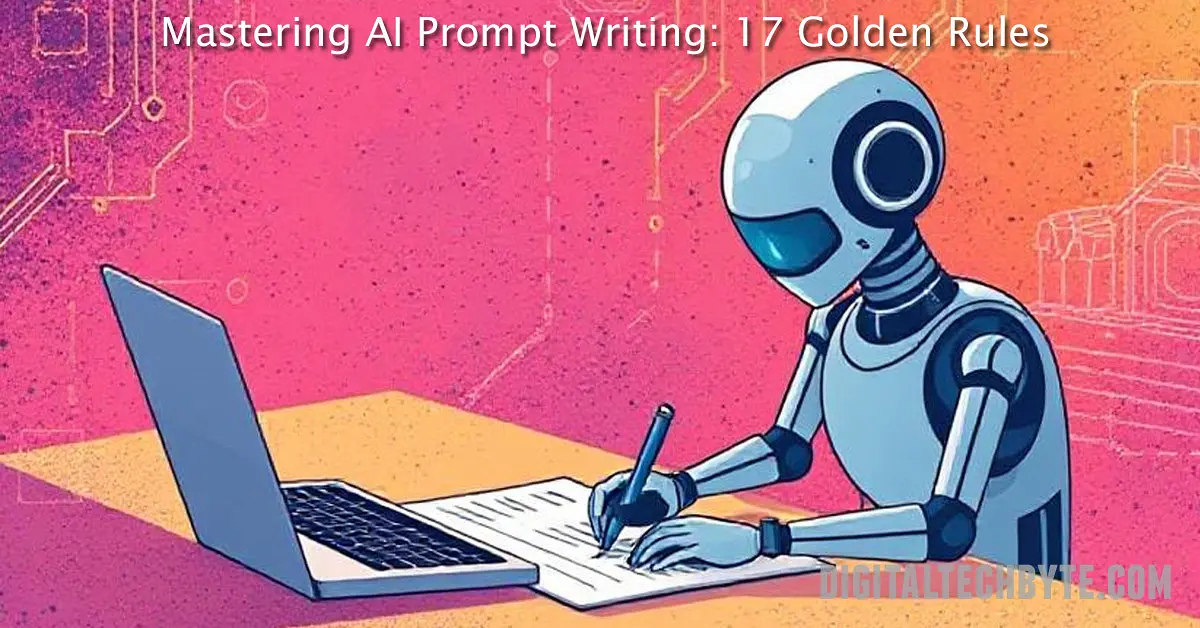
Mastering AI Prompt Writing: 17 Golden Rules with 10 Best Prompt Examples and a Case Study
Unlock AI’s full potential with these 17 golden rules for AI prompt writing. Explore top prompt examples and a practical case study to craft effective, engaging AI interactions.
Mastering AI Prompt Writing: 17 Golden Rules to Unlock AI’s True Power
AI has transformed the way we create, communicate, and solve problems. However, getting the most out of AI tools like ChatGPT, Google Gemini, or other language models depends heavily on how well you craft your prompts. Think of prompt writing as an art and a science—it’s the key to unlocking high-quality, relevant, and accurate AI-generated content.
Here are the 17 golden rules to write great AI prompts that deliver precisely what you need:
-
Define the Objective: Be clear about your goal. Tell the AI exactly what you want it to do.
-
Assign a Role: Set context by asking AI to assume a specific role (e.g., marketer, educator).
-
Identify the Audience: Mention who the output is for, so the style and complexity fit your target reader.
-
Provide Context: Give background information to help AI understand the scenario better.
-
Specify the Format: If you want responses in bullets, paragraphs, or tables, say so.
-
Set Constraints: Define word count, tone, topics to avoid, or style preferences.
-
Use Clear, Precise Language: Avoid ambiguity to reduce guesswork by the AI.
-
Include Examples: Show what you want by adding sample outputs or templates.
-
Specify Tone and Style: Formal, casual, humorous, or serious—make it clear.
-
Focus on One Task at a Time: Avoid combining multiple requests in one prompt.
-
Encourage Creativity: When appropriate, ask AI to think outside the box or suggest new ideas.
-
Request Citations for Facts: When dealing with data or historical content, ask for sources.
-
Define or Explain Technical Terms: Prevent misunderstandings by clarifying jargon.
-
Be Concise but Detailed Enough: Short prompts can work, but too little info leads to vagueness.
-
Iterate and Refine: Experiment and tweak your prompts to improve outputs.
-
Use Few-Shot Examples Sparingly: When teaching style or format, a couple of examples suffice.
-
Think in Terms of the End Goal: Always design your prompt with the final output in mind.
10 Best AI Prompt Examples in Practice
To make these rules actionable, here are 10 examples demonstrating how great prompts look across various use cases:
-
Creative Writing:
“Write a first-person narrative from the perspective of a sailor lost at sea during a storm, using vivid imagery and suspenseful tone.” -
Professional Email:
“Draft a polite follow-up email to a client after a missed meeting, apologizing briefly and requesting a reschedule.” -
Technical Explanation:
“Explain quantum computing in simple terms suitable for a high-school student, including real-world applications.” -
SEO Blog Intro:
“Write a 150-word introduction for a blog post about the impact of AI on digital marketing, targeting small business owners.” -
Customer Support FAQ:
“Create five concise FAQs for a new online shopping app, addressing account creation, payment options, delivery, and returns.” -
Data Summary:
“Summarize these survey results about remote work trends in three bullet points, highlighting key statistics.” -
Code Generation:
“Write a Python function that accepts a list of numbers and returns their average, with error handling for empty lists.” -
Translation with Style:
“Translate this English poem into Spanish, keeping the rhyme and emotional tone intact.” -
Brainstorming:
“Suggest 10 innovative social media campaign ideas for promoting eco-friendly products during Earth Month.” -
Learning Assistant:
“Provide a step-by-step explanation of how photosynthesis works for a general science audience.”
Case Study: Improving Marketing Content with AI Prompt Writing
A digital marketing agency wanted to use AI to streamline content creation but found initial outputs too generic. By applying the golden rules, they refined their prompts by:
-
Assigning a role: “Act as a senior content strategist.”
-
Specifying the audience: “Write for mid-level marketing managers.”
-
Setting constraints: “Use a professional yet approachable tone in around 300 words.”
-
Including examples: Providing sample intros and conclusions.
The result? AI-generated blog posts that were more aligned with the brand voice, engaged the target readers effectively, and reduced editing time by 50%. This practical application demonstrates how thoughtful prompt design leads to tangible productivity and quality gains.
Prompt writing is evolving alongside AI itself. The deeper your understanding and the more precise your instructions, the better AI assists you. These 17 golden rules, paired with strong examples and real-world cases, empower you to harness AI not as a tool you feed blindly but as a collaborator you guide skillfully.
